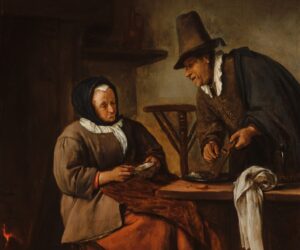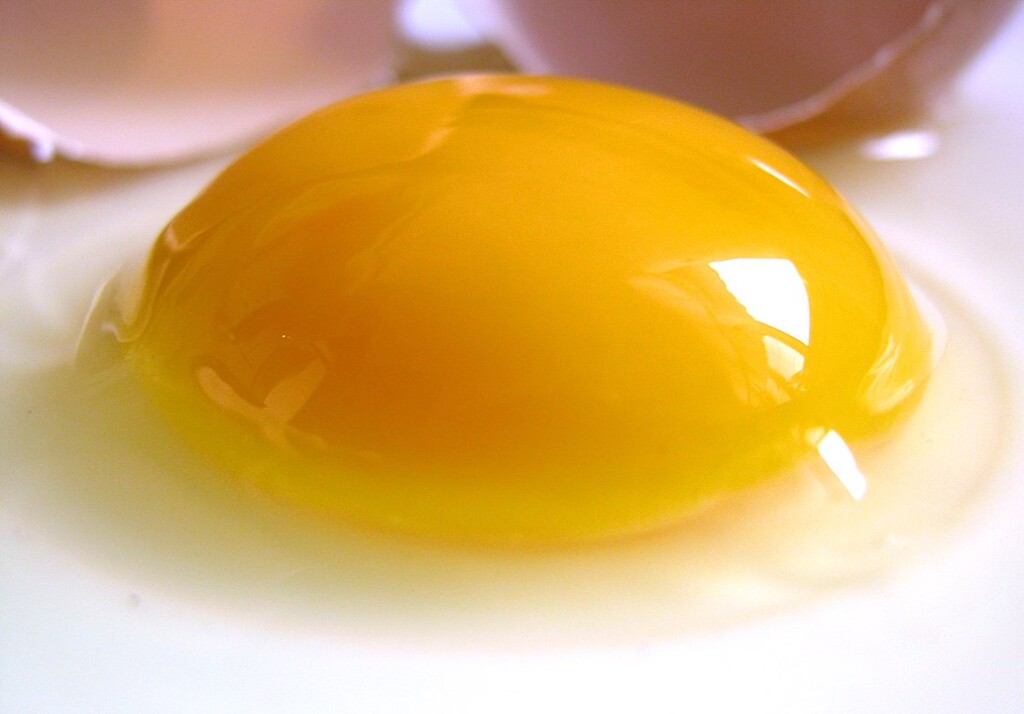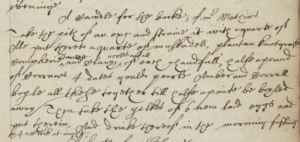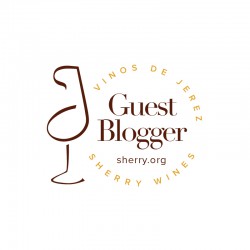
Eggs are everywhere this weekend, although our local supermarkt has already removed the chocolate versions. Luckily, there were still enough real eggs, so I can start my Easter Sunday with a breakfast with eggs. I won’t go into all the reasons eggs are part of the Easter folklore, there are no doubt enough blogs and articles online to read more about that.
But recently, I was asked by Colombian bartender Ivan Antonio Ramirez about the history of the Dutch drink candeel, or kandeel as we now write it. Kandeel is based on egg yolks and wine, and Ivan Antonio is preparing a book on the egg in coctail drinks. He wanted to research its history and was looking for the connection with candiel, a drink with egg yolks and wine as known in Colombia. May be an answer was to be found in the history of Spain and the Netherlands in the 16th century?
I was not able to help him out with that directly, but I did find out that kandeel has a very long and interesting history in the Netherlands, in which the health restoring properties play an important role. Here you have a link with Easter: spring, greens sprouting, chickens back to laying eggs, nature rejuvenating, restoring itself. This article is a reworked version of the answers I send to Ivan Antiono, in honor of the strong connection of Easter with eggs.
Cookbooks
The oldest mention in a printed Dutch cook book of the word candeel dates from 1514, in Een notabel boecxken van cokeryen, which actually is the oldest printed cookbook in the Low Countries. It was printed in Brussels by Thomas van der Noot. The recipe in Dutch reads
Als een candeel gheronnen [gestold] es,
soe sal ment setten in cout watere ende rueret altoos totdat cout sy. Ende met deser manieren saelt ontrinnen [weer vloeibaar worden]: dan suldijt weder over tver [op het vuur] doen ende latent sieden [koken].
[Source: www.kookhistorie.nl]
Translated this would be
If a candeel is solidified
put it in cold water and stir untill cold. In this way, it will liquify; put in on the fire again and let it boil.
There is no explanation as to what a candeel is. But just above is a recipe for a wijnsuypen, a kind of sauce or wine soup, to go with veal or lam. In this recipe, egg yolks are combined with flour and wine, the mixture is boiled, and then the meat is put in and everything is boiled some more. Below is the original recipe. There is no sugar mentioned in the ingredients.
Om een wijnsuypen tot calfvleessche oft lamvleessche
Men sal nemen eenen deel doderen [dooiers] van rouwen eyeren ende dye sal men met luttelle bloemen [bloem] breken wel ontwee [goed loskloppen] ende met luttel wijns. Alst aldus wel ghetempert [goed vermengd] es, soe sal ment lynghen [aanlengen] met wijne ende met verjuyse, met oock wat van den maghersten sope, nadat ghijs veel [naar gelang dat u er veel van] hebben wilt, ende latent wel sieden [koken]. Dan sal men tvleesch daerinne doen ende latent mitsieden [meekoken], maer seer weynich.
[Source: www.kookhistorie.nl]

The Sensible Cook
The next two known printed cook books in the Dutch language date from the second half of the 16th century. Both don’t have the word candeel or kandeel. The most well known historical cook book in the Netherlands is, however, De Verstandige Kok (The Sensible Cook), from 1669. And this cook book does have a recipe for kandeel:
Om een leckere kandeel te maken
Neemt een pint water en een pint Rinse wijn, en slaet 6 eyeren heel kleen sonder de haen, en roert het onder malkanderen. Set het op ’t vuur tot het aen de koock komt. Doet er dan wel suyker, foelie, notemuskaet, caneel en nagelen by. ’t Is goet om te drincken. Sommige doen dat wel over een gestooft hoen voor saus. Oock harst mender wel wittebroot in om te eeten. Sommige doender wel boter in.
[Source: www.kookhistorie.nl]
In translation:
To make a tasty kandeel
Take a pint of water and a pint of Rhine wine and beat 6 eggs very well, without the cock (the whites) and stir it well. Put it on the fire till it boils. Put some sugar, mace, nutmeg, cinnamon and cloves in. It is well to drink. Some put it on stewed hen (chicken) for a sauce. Also, some put rasped white bread in it to eat and some put in butter.
To me, this discription suggests a clear link with the sauce mentioned in 1514, the wijnsuypen, although now sugar and spices have been added. Later on, we also find wijnsoepen (wine soups) in the cookbooks of the 18th century, also based on wine and egg yolks, but those are sour rather than sweet. The drink kandeel stays sweet from now on, and will become a drink especially given to mothers who have just deliverd a baby. Several traditions grew up around serving kandeel in the 18th century (those traditions might date from earlier times, but I have not researched that aspect). Wine soups also remain, but they are more sour then sweet, to my knowledge, and are a kind of pick-me-up in general. I made one once, you get a nice kick out of it.
Dictionaries
Next for some information from our historical dictionaries. The Middle Dutch Dictionary has several sources for candeel. The oldest is from 1351, in a medical text from Flanders by a surgeon called Jan Yserman. In his medical work, a candeel is a hot drink made with beer or wine. The other mention is a literary work by author Jacob van Maerlant, in an edition from c. 1470. In this work, candeel is given to a wounded person, to heal and get well. Also mentioned is a play from 1530 by Cornelis Everaert, which mentions a candeel ofte een zupen. Here again is the connection between candeel and suypen / zupen. Those two words have a clear relationship both with modern Dutch zuipen, which once meant simple ‘drinking’, but now ‘drinking too much’. And there is a good chance that there is also a link with modern Dutch soep, soup.
An enlightening mention is found in a work printed in Antwerp in 1573, by the famous Christofel Plantijn. In this Thesavrvs Thevtonicae lingvae / Schat der Neder-duytscher spraken, we find:
‘Een Kandeel. Vn chaudeau, ou humet faict de canelle et sucre
Een suypen, suypken, oft kandeel. Un humet, ou chaudeau à humer’
So here again is a clear link between kandeel and suypen. Also interesting is the link to French chaudeau, a liquid food made of comparable ingredients. In fact, the cinnamon (canelle) and sugar (sucre) are explicitly mentioned. Chaudeau is related to north French caudel, and this is in accordance with Dutch etymological dictionaries, which give as origin of the word candeel the north French (Picardic) caudel, which in its turn comes from Latin caldellum, a hot drink. The word caudel also entered the English language as caudle or cawdle. Recipes for cawdles, a sauce but also a health restoring liquid type of food, often with egg yolks, are all over the 16th century recipe books I have helped transcribe for The Folger Library.

Caldellum – caudel – cawdle – candeel
So to summarize: it is very likely that from the north French caudel and the English caudle, the word candeel comes first – somewhere in the Middle Ages – to Flanders, then to the north of the Low Countries. It was certainly known in both the south (present day Belgium) and the north from the late 15th century. It was a restoring kind of liquid food, or soup, in the beginning, also used as a sauce for meat (or may be the other way around…)
From the 17th century and certainly in the 18th century candeel as a drink becomes very well known in the north. Sugar and spices have then been added, and the mixture of egg yolks and wine is now a drink to enjoy on its own. It still counts as a restoring and healing kind of liquid food, also, mostly given to new mothers.
Unfortunately, to confuse matters more, we have a ‘drink’ called advocaat in the Netherlands. This is a custardlike mixture of egg yolks, brandy and some sugar, which is spooned out of a little glass to enjoy, mostly by elderly women around five o’clock. Sometimes it is topped by whipped cream. I have not discovered the relationship between kandeel and advocaat yet (other then egg yolks and sugar). Advocaat seems like an invention from the 19th century, however. The English Wikipedia gives the most extensive background story, but is it all true? Is there a connection with a drink from avocado’s from Brasil?
Whatever the truth: it does show that eggs and especially egg yolks have been part of the tradition of alcoholic drinks for centuries, and still are! And eggs have been connected with life, life restoring properties and healing equally long, may be longer. I am looking forward to Ivan Antonio Ramirez’ book!
